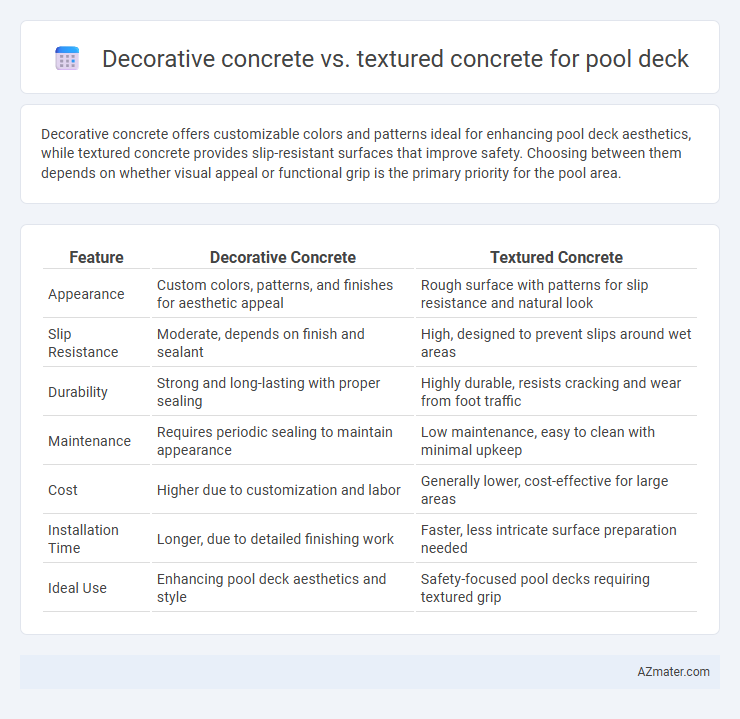Decorative concrete offers customizable colors and patterns ideal for enhancing pool deck aesthetics, while textured concrete provides slip-resistant surfaces that improve safety. Choosing between them depends on whether visual appeal or functional grip is the primary priority for the pool area.
Table of Comparison
| Feature | Decorative Concrete | Textured Concrete |
|---|---|---|
| Appearance | Custom colors, patterns, and finishes for aesthetic appeal | Rough surface with patterns for slip resistance and natural look |
| Slip Resistance | Moderate, depends on finish and sealant | High, designed to prevent slips around wet areas |
| Durability | Strong and long-lasting with proper sealing | Highly durable, resists cracking and wear from foot traffic |
| Maintenance | Requires periodic sealing to maintain appearance | Low maintenance, easy to clean with minimal upkeep |
| Cost | Higher due to customization and labor | Generally lower, cost-effective for large areas |
| Installation Time | Longer, due to detailed finishing work | Faster, less intricate surface preparation needed |
| Ideal Use | Enhancing pool deck aesthetics and style | Safety-focused pool decks requiring textured grip |
Introduction to Pool Deck Surfacing Options
Decorative concrete offers versatile design choices including stamped, stained, or exposed aggregate finishes that enhance pool deck aesthetics while providing durability and slip resistance. Textured concrete focuses on surface modifications like broom finishes or trowel patterns that improve traction and safety around wet areas without extensive customization. Both options provide functional and visually appealing solutions tailored to pool environments, balancing style and performance based on homeowner preferences and budget.
What is Decorative Concrete?
Decorative concrete for pool decks involves adding color, patterns, and textures to traditional concrete surfaces to enhance aesthetic appeal and complement outdoor design themes. It includes stamped concrete, stained concrete, and exposed aggregate finishes that provide unique visual effects while maintaining durability and slip resistance. This approach not only improves the overall look but also offers customization options tailored to poolside environments.
What is Textured Concrete?
Textured concrete for pool decks involves creating patterns or embossed surfaces that enhance slip resistance and aesthetic appeal, making it ideal for safety around wet areas. Unlike decorative concrete, which primarily focuses on artistic finishes such as staining, stamping, or coloring, textured concrete emphasizes tactile surface modifications to improve grip and durability. Common textures include broom finishes, exposed aggregate, and stamped patterns designed specifically to prevent slips and withstand outdoor poolside conditions.
Visual Appeal: Decorative vs Textured Concrete
Decorative concrete for pool decks offers intricate patterns, vibrant colors, and custom designs that elevate the overall aesthetic, creating a polished and sophisticated look. Textured concrete emphasizes functional appeal with its slip-resistant surface and natural stone-like finish, blending durability with subtle visual interest. Choosing between decorative and textured concrete depends on the desired balance between artistic expression and practical safety features for pool surroundings.
Slip-Resistance and Safety Comparison
Decorative concrete for pool decks offers customizable aesthetics with moderate slip resistance enhanced by sealers and additives designed to improve safety. Textured concrete provides superior slip resistance due to its rough surface finish, making it a safer option for wet pool environments. Choosing textured concrete minimizes slip hazards and enhances durability, ideal for high-traffic pool areas where safety is paramount.
Durability and Maintenance Factors
Decorative concrete for pool decks offers enhanced durability through specialized sealants that resist stains, fading, and wear from chemicals and UV exposure, making it a low-maintenance option compared to traditional textured concrete. Textured concrete provides slip-resistant surfaces ideal for safety around pools but may require more frequent cleaning and resealing to prevent algae buildup and surface degradation. Selecting the appropriate finish depends on balancing long-term durability with maintenance demands tailored to the pool environment.
Installation Process Differences
Decorative concrete installation for pool decks involves intricate techniques such as stamping, staining, or engraving to achieve customized artistic patterns and vibrant colors, requiring skilled labor and specialized tools. Textured concrete, on the other hand, is applied using stamping mats or broom finishes immediately after pouring, emphasizing slip resistance and simpler surface variations with generally faster setup times. The curing and sealing stages are crucial for both methods to ensure durability against pool chemicals and weather conditions, but decorative concrete often demands longer curing periods due to additional layers and treatments.
Cost Considerations for Pool Decks
Decorative concrete for pool decks generally costs more due to intricate designs, staining, and stamping techniques that enhance aesthetic appeal and customization options. Textured concrete is a more budget-friendly option, offering slip-resistant surfaces with simpler finishes that still provide durability and safety around pools. Cost considerations should include not only initial installation but also maintenance requirements, as decorative finishes may need periodic resealing to preserve appearance, whereas textured surfaces typically require less upkeep.
Pros and Cons of Decorative Concrete Pool Decks
Decorative concrete pool decks offer customizable aesthetics, including stamped patterns, dyes, and stains that enhance poolside ambiance while providing durability and low maintenance. However, decorative concrete may be more prone to fading or surface wear over time, requiring occasional sealing to preserve its appearance. Compared to textured concrete, it generally provides a smoother surface that can be slippery when wet, making slip resistance an important consideration for pool safety.
Choosing the Best Concrete Finish for Your Pool Deck
Decorative concrete offers vibrant colors and intricate patterns, enhancing the aesthetic appeal of your pool deck with customizable designs like stamped, stained, or exposed aggregate finishes. Textured concrete provides superior slip resistance and durability, making it ideal for safety around wet pool areas by mimicking natural materials such as slate, wood, or tile. Selecting the best finish depends on balancing visual impact with functional benefits, ensuring your pool deck combines beauty, safety, and long-term performance.

Infographic: Decorative concrete vs Textured concrete for Pool deck
 azmater.com
azmater.com